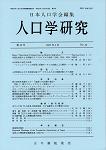Volume 36
Displaying 1-32 of 32 articles from this issue
- |<
- <
- 1
- >
- >|
Index
-
Article type: Cover
2005Volume 36 Pages Cover1-
Published: May 31, 2005
Released on J-STAGE: September 12, 2017
Download PDF (847K) -
Article type: Index
2005Volume 36 Pages Toc1-
Published: May 31, 2005
Released on J-STAGE: September 12, 2017
Download PDF (847K) -
Article type: Appendix
2005Volume 36 Pages App1-
Published: May 31, 2005
Released on J-STAGE: September 12, 2017
Download PDF (444K)
Article
-
Article type: Article
2005Volume 36 Pages 1-12
Published: May 31, 2005
Released on J-STAGE: September 12, 2017
Download PDF (992K)
Note
-
Article type: Article
2005Volume 36 Pages 13-22
Published: May 31, 2005
Released on J-STAGE: September 12, 2017
Download PDF (544K) -
Article type: Article
2005Volume 36 Pages 23-40
Published: May 31, 2005
Released on J-STAGE: September 12, 2017
Download PDF (864K) -
Article type: Article
2005Volume 36 Pages 41-55
Published: May 31, 2005
Released on J-STAGE: September 12, 2017
Download PDF (694K)
In Memoriam
-
Article type: Article
2005Volume 36 Pages 78-
Published: May 31, 2005
Released on J-STAGE: September 12, 2017
Download PDF (429K) -
Article type: Article
2005Volume 36 Pages 79-
Published: May 31, 2005
Released on J-STAGE: September 12, 2017
Download PDF (367K)
Book Reviews
-
Article type: Article
2005Volume 36 Pages 56-58
Published: May 31, 2005
Released on J-STAGE: September 12, 2017
Download PDF (614K) -
Article type: Article
2005Volume 36 Pages 59-61
Published: May 31, 2005
Released on J-STAGE: September 12, 2017
Download PDF (515K) -
Article type: Article
2005Volume 36 Pages 62-65
Published: May 31, 2005
Released on J-STAGE: September 12, 2017
Download PDF (648K) -
Article type: Article
2005Volume 36 Pages 66-67
Published: May 31, 2005
Released on J-STAGE: September 12, 2017
Download PDF (806K) -
Article type: Article
2005Volume 36 Pages 67-68
Published: May 31, 2005
Released on J-STAGE: September 12, 2017
Download PDF (810K) -
Article type: Article
2005Volume 36 Pages 68-69
Published: May 31, 2005
Released on J-STAGE: September 12, 2017
Download PDF (811K) -
Article type: Article
2005Volume 36 Pages 69-70
Published: May 31, 2005
Released on J-STAGE: September 12, 2017
Download PDF (705K) -
Article type: Article
2005Volume 36 Pages 70-71
Published: May 31, 2005
Released on J-STAGE: September 12, 2017
Download PDF (705K) -
Article type: Article
2005Volume 36 Pages 72-73
Published: May 31, 2005
Released on J-STAGE: September 12, 2017
Download PDF (505K) -
Article type: Article
2005Volume 36 Pages 73-74
Published: May 31, 2005
Released on J-STAGE: September 12, 2017
Download PDF (878K) -
Article type: Article
2005Volume 36 Pages 74-75
Published: May 31, 2005
Released on J-STAGE: September 12, 2017
Download PDF (672K) -
Article type: Appendix
2005Volume 36 Pages 76-77
Published: May 31, 2005
Released on J-STAGE: September 12, 2017
Download PDF (672K)
PAJ Information
-
Article type: Appendix
2005Volume 36 Pages 80-83
Published: May 31, 2005
Released on J-STAGE: September 12, 2017
Download PDF (583K) -
Article type: Appendix
2005Volume 36 Pages 84-
Published: May 31, 2005
Released on J-STAGE: September 12, 2017
Download PDF (321K) -
Article type: Bibliography
2005Volume 36 Pages 85-92
Published: May 31, 2005
Released on J-STAGE: September 12, 2017
Download PDF (666K) -
Article type: Appendix
2005Volume 36 Pages 93-94
Published: May 31, 2005
Released on J-STAGE: September 12, 2017
Download PDF (486K) -
Article type: Appendix
2005Volume 36 Pages 95-
Published: May 31, 2005
Released on J-STAGE: September 12, 2017
Download PDF (373K) -
Article type: Appendix
2005Volume 36 Pages 96-
Published: May 31, 2005
Released on J-STAGE: September 12, 2017
Download PDF (424K) -
Article type: Appendix
2005Volume 36 Pages 98-
Published: May 31, 2005
Released on J-STAGE: September 12, 2017
Download PDF (354K) -
Article type: Appendix
2005Volume 36 Pages 93-
Published: May 31, 2005
Released on J-STAGE: September 12, 2017
Download PDF (354K) -
Article type: Appendix
2005Volume 36 Pages App2-
Published: May 31, 2005
Released on J-STAGE: September 12, 2017
Download PDF (444K) -
Article type: Cover
2005Volume 36 Pages Cover2-
Published: May 31, 2005
Released on J-STAGE: September 12, 2017
Download PDF (180K) -
Article type: Index
2005Volume 36 Pages Toc2-
Published: May 31, 2005
Released on J-STAGE: September 12, 2017
Download PDF (180K)
- |<
- <
- 1
- >
- >|
